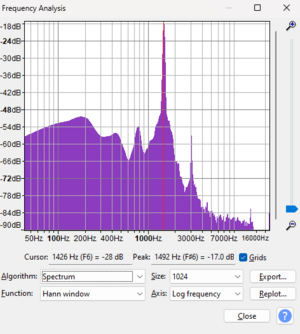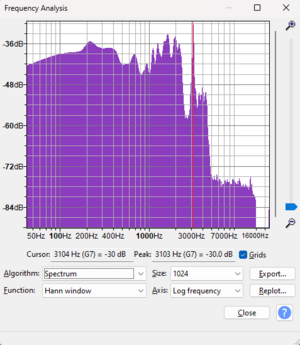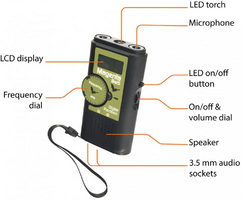PHYS341/2024/Project3
Ultrasonic Vocalizations of Rats and Mice

Ultrasonic vocalizations (USVs) are sounds commonly produced in rats and mice that are above the humans hearing range (20Hz to 20,000Hz)[2] but have caught our ears and our research. These vocalizations have been of particular interest in the fields of physics and psychology because of their role in physical changes in production depending on affective states (emotional states), age, social context, and genetics[3][4] of the rodent. Understanding the physics behind the production of USVs has helped us understand rodent communication and we have been able to apply this research to human communication as well. Consequently, they can be an accurate animal model for researching human psychology. For example, these studies have been an integral part of our understanding of various neurodevelopmental disorders.
Background
USVs are categorized into three frequency ranges but are more commonly referred to by a single frequency:

22kHz (18-32kHz)
40kHz (40-70kHz)
50kHz (35-72kHz)

What determines which frequency a rodent makes depends on a variety of factors. The most prevalent being the emotionality of the animal. It is not simply an autonomic response, but a form of intraspecies communication during various species-specific activities. According to a paper by Brudzynski (2021)[6], the neural mechanisms that start the emotion are common when vocalizing these frequencies. In the same paper it is concluded that the 22kHz vocalizations are broadly used in aversive situations and the 50kHz calls are used in appetitive situations. Aversive situations can be those such as: withdrawal of parental care, bright light in novel conditions, and shocks. Appetitive situations can include attracting other rats, huddling in juveniles, and tickling of adult rats by humans.

Physics
Creating Sound
Boulanger-Bertolus et al. explain that rats produce USVs from, first, inspiration, then the larynx stabilizes, and then the vocal folds are tightened which leaves a small opening to create a whistle like noise[1]. This also requires a contraction of abdominal muscles and spine muscles. Because of this reliance on musculature, certain frequencies will be more common during different activities. For example, freezing behaviour is required for 22kHz calls while locomotion often results in 50 kHz calls. As an interesting visual, one paper has suggested that circling motion of rodents means a projecting an ultrasonic “beam” in the circular direction[8].
Measuring Sound

The most common way of measuring USVs in research is with a bat detector[10]. This is a device that can get the inputs from the ultrasonic sound waves of bats, rodents, and mice, and convert them into sounds that humans can hear. This ranges from 120Hz to 15kHz[11].
Age and Sound
The production of frequencies paired with specific affective states is not a clear-cut as it may seem. The frequency pairings shift as a function of age. It is known that when given a shock, rodents will most often give out a 22kHz vocalization. This is different in infants and juveniles. The frequency of the calls decreases from 40kHz to 30kHz to 22kHz as the rats age and it is suggested that this is caused by the increase in the size and length of the larynx and vocal tract[10]. That is why the calls in Figure 1 show 40kHz rather than the typical 22kHz calls for aversive situations. This change in frequencies are in contrast with the inconsistent research on the effects of aging on the human voice[12].
Human vs Rat Sound
If we compare the production of audible sound between rodents and humans, audible vocalizations of both species are created the same way: vibration of vocal folds[10]. This is different from how USVs are produced because USVs require the tightening of the vocal folds while leaving a small gap to create a whistle tone. Given that the vocal folds in USVs are not vibrating, and the vocal tract formants of a rat are much smaller in size than a human's, it makes sense that rats have fewer overtones over the fundamental frequencies they produce[13]. One could expect the resulting spectrogram of rat USVs to have a different shape, amplitudes, and frequency of frequencies.
Psychology
Many researchers have used rodents as an animal model for autism because they are able to see changes in social communication with or without certain genetics[14] [15]. Some specifically have used inbred genetics that result in social abnormalities and repetitive behaviours that are similar to diagnostic symptoms of autism to see the differences in the mice calls in various situations[14]. They found that these rats had louder, more frequent calls with more harmonics – possible due to the larger body weight and thoracic size. They suggested that there may be “different lexicons, or innate variations in complex vocal repertoires” in mice with specific genetics. In later studies[15], they were able to use vocalizations as means for phenotyping mice.
One group of researchers[16] was able to create an animal model for Angelman syndrome where speech is atypical. The rat had many of the same physiological brain features but also had excessive laughter-like (50 kHz) vocalizations. In the future, researchers will be able to use this model for finding cures or therapies for the syndrome which currently does not have any.
Vocalizations have also been used in research for seizures and epilepticus[17] and have discovered that seizures in the early lives of mice result in fewer 50 kHz vocalizations in the future.
Rat and mouse USVs are a crucial component to animal models used in psychology. Because we understand the physiology of the rodents, how the sounds are produced, and how they are different from that of humans, we have been able to apply our understanding and answer new questions using the new tools we have created. Animal models are crucial to research because it allows us to carefully alter genetics, environment, and variables on a smaller scale, especially in scenarios that would be unethical to do so with humans.
References
- ↑ 1.0 1.1 Boulanger-Bertolus, Rincón-Cortés, Sullivan, Mouly (2017). "Understanding pup affective state through ethologically significant ultrasonic vocalization frequency".CS1 maint: multiple names: authors list (link)
- ↑ Van Raamsdonk, Mark (Apr 25, 2021). "Physics of Music 41: Frequency sensitivity of hearing, frequency ratio vs pitch difference".
- ↑ Jackson, Justin. "Cross-fostering experiment reveals genetic basis of mouse communication".
- ↑ Bergdorf, Panksepp, Brudsynski, Kroes, Moskal. "Breeding for 50-kHz Positive Affective Vocalization in Rats".CS1 maint: multiple names: authors list (link)
- ↑ 5.0 5.1 "This algorithm decodes rat squeaks and could revolutionize animal research". YouTube. February 19, 2019.
|first=missing|last=(help) - ↑ Brudzynski, Stefan F. (2021). "Biological Functions of Rat Ultrasonic Vocalizations, Arousal Mechanisms, and Call Initiation".
- ↑ "Rat Anatomy - Head, Thoracic, and Abdominal Organs". April 9, 2024.
|first=missing|last=(help) - ↑ Haack (1983). "Sound communication between parents and offspring".
- ↑ "Magenta Bat 5 Bat Detector". NHBS. April 9, 2024.
- ↑ 10.0 10.1 10.2 Boulanger-Bertolus; et al. "Ultrasonic Vocalizations Emission across Development in Rats: Coordination with Respiration and Impact on Brain Neural Dynamics". Brain Sci. Explicit use of et al. in:
|last=(help) - ↑ "Bat Detector". April 5, 2024.
- ↑ Eichhorn, Kent, Austin, Vorperian (2017). "Effects of Aging on Vocal Fundamental Frequency and Vowel Formants in Men and Women".CS1 maint: multiple names: authors list (link)
- ↑ Brudzynski, Stefan F. (2009). "Communication of Adult Rats by Ultrasonic Vocalization: Biological, Sociobiological, and Neuroscience Approaches".
- ↑ 14.0 14.1 Scattoni, Maria Luisa (2008). "Unusual Repertoire of Vocalizations in the BTBR T+tf/J Mouse Model of Autism".
- ↑ 15.0 15.1 Scattoni; Crawley; Ricceri (2009). "Ultrasonic vocalizations: A tool for behavioural phenotyping of mouse models of neurodevelopmental disorders".CS1 maint: multiple names: authors list (link)
- ↑ Elizabeth L. Berg, Shekib A. Jami, Stela P. Petkova, Annuska Berz, Timothy A. Fenton, Jason P. Lerch, David J. Segal, John A. Gray, Jacob Ellegood, Markus Wöhr and Jill L. Silverman (2021). "Excessive Laughter-like Vocalizations, Microcephaly, and Translational Outcomes in the Ube3a Deletion Rat Model of Angelman Syndrome".CS1 maint: multiple names: authors list (link)
- ↑ Reynolds, Smith, Jefferson, Lugo (2016). "The effect of early life status epilepticus on ultrasonic vocalizations in mice".CS1 maint: multiple names: authors list (link)